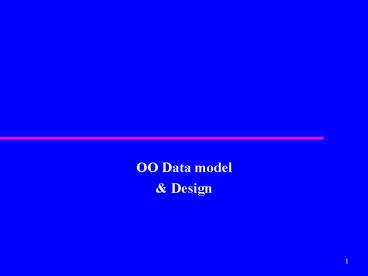OO Data model - PowerPoint PPT Presentation
1 / 26
Title:
OO Data model
Description:
Data model that captures semantics of objects supported in object-oriented ... Itasca from Ibex Knowledge Systems SA, Objectivity/DB from Objectivity Inc. ... – PowerPoint PPT presentation
Number of Views:125
Avg rating:3.0/5.0
Title: OO Data model
1
- OO Data model
- Design
2
Object-Oriented Data Model
- No one agreed object data model. One definition
- Object-Oriented Data Model (OODM)
- Data model that captures semantics of objects
supported in object-oriented programming. - Object-Oriented Database (OODB)
- Persistent and sharable collection of objects
defined by an ODM. - Object-Oriented DBMS (OODBMS)
- Manager of an ODB.
3
Object-Oriented Data Model
- Zdonik and Maier present a threshold model that
an OODBMS must, at a minimum, satisfy - It must provide database functionality.
- It must support object identity.
- It must provide encapsulation.
- It must support objects with complex state.
4
Object-Oriented Data Model
- Khoshafian and Abnous define OODBMS as
- OO ADTs Inheritance Object identity
- OODBMS OO Database capabilities.
- Parsaye et al. gives
- High-level query language with query
optimization. - Support for persistence, atomic transactions
concurrency and recovery control. - Support for complex object storage, indexes, and
access methods. - OODBMS OO system (1), (2), and (3).
5
Origins of the Object-Oriented Data Model
6
Commercial OODBMSs
- GemStone from Gemstone Systems Inc.,
- Itasca from Ibex Knowledge Systems SA,
- Objectivity/DB from Objectivity Inc.,
- ObjectStore from eXcelon Corp.,
- Ontos from Ontos Inc.,
- Poet from Poet Software Corp.,
- Jasmine from Computer Associates/Fujitsu,
- Versant from Versant Object Technology.
7
Alternative Strategies for Developing an OODBMS
- Extend existing object-oriented programming
language. - GemStone extended Smalltalk.
- Provide extensible OODBMS library.
- Approach taken by Ontos, Versant, and
ObjectStore. - Embed OODB language constructs in a conventional
host language. - Approach taken by O2,which has extensions for C.
8
Alternative Strategies for Developing an OODBMS
- Extend existing database language with
object-oriented capabilities. - Approach being pursued by RDBMS and OODBMS
vendors. - Ontos and Versant provide a version of OSQL.
- Develop a novel database data model/language.
9
OODBMS Manifesto
- Complex objects must be supported.
- Object identity must be supported.
- Encapsulation must be supported.
- Types or Classes must be supported.
- Types or Classes must be able to inherit from
their ancestors. - Dynamic binding must be supported.
- The DML must be computationally complete.
10
OODBMS Manifesto
- The set of data types must be extensible.
- Data persistence must be provided.
- The DBMS must be capable of managing very large
databases. - The DBMS must support concurrent users.
- DBMS must be able to recover from
hardware/software failures. - DBMS must provide a simple way of querying data.
11
OODBMS Manifesto
- The manifesto proposes the following optional
features - Multiple inheritance, type checking and type
inferencing, distribution across a network,
design transactions and versions. - No direct mention of support for security,
integrity, views or even a declarative query
language.
12
Advantages of OODBMSs
- Enriched Modeling Capabilities.
- Extensibility.
- Removal of Impedance Mismatch.
- More Expressive Query Language.
- Support for Schema Evolution.
- Support for Long Duration Transactions.
- Applicability to Advanced Database Applications.
- Improved Performance.
13
Disadvantages of OODBMSs
- Lack of Universal Data Model.
- Lack of Experience.
- Lack of Standards.
- Query Optimization compromises Encapsulation.
- Object Level Locking may impact Performance.
- Complexity.
- Lack of Support for Views.
- Lack of Support for Security.
14
Object-Oriented Database Design
15
Relationships
- Relationships represented using reference
attributes, typically implemented using OIDs. - Consider how to represent following binary
relationships according to their cardinality - 11
- 1
- .
16
11 Relationship Between Objects A and B
- Add reference attribute to A and, to maintain
referential integrity, reference attribute to B.
17
1 Relationship Between Objects A and B
- Add reference attribute to B and attribute
containing set of references to A.
18
Relationship Between Objects A and B
- Add attribute containing set of references to
each object. - For relational database design, would decompose
N into two 1 relationships linked by
intermediate entity. Can also represent this
model in an ODBMS.
19
Relationships
20
Alternative Design for Relationships
21
Referential Integrity
- Several techniques to handle referential
integrity - Do not allow user to explicitly delete objects.
- System is responsible for garbage collection.
- Allow user to delete objects when they are no
longer required. - System may detect invalid references
automatically and set reference to NULL or
disallow the deletion.
22
Referential Integrity
- Allow user to modify and delete objects and
relationships when they are no longer required. - System automatically maintains the integrity of
objects. - Inverse attributes can be used to maintain
referential integrity.
23
Behavioral Design
- EER approach must be supported with technique
that identifies behavior of each class. - Involves identifying
- public methods visible to all users
- private methods internal to class.
- Three types of methods
- constructors and destructors
- access
- transform.
24
Behavioral Design - Methods
- Constructor - creates new instance of class.
- Destructor - deletes class instance no longer
required. - Access - returns value of one or more attributes
(Get). - Transform - changes state of class instance (Put).
25
Identifying Methods
- Several methodologies for identifying methods,
typically combine following approaches - Identify classes and determine methods that may
be usefully provided for each class. - Decompose application in top-down fashion and
determine methods required to provide required
functionality.
26
Database design with UML
- Class diagram are used to capture a conceptual
model of the database schema, including, classes,
attributes, methods and references - Other structural and behavioral diagrams can also
be used during requirements collection, analysis,
and application design

